
We bought this bag in Konya in 1991. It appears to be reciprocal brocade. The back is not original. Yes, those are feathers adorning the top.
Happy New Year to all.
Rick
Hash Gul Revisited...Again
Here is the picture of the bag I promised a month or so ago during Louis
Dubreuil's 'Hash Gul' discussion (archived at http://www.turkotek.com/misc_00021/hash_gul.htm). 
We bought this
bag in Konya in 1991. It appears to be reciprocal brocade. The back is not
original. Yes, those are feathers adorning the top.
Happy New Year to
all.
Rick
happy new hash gul
Bonjour Rick et bonne année
Your picture is very interesting. This
piece can be an anatolian one. I have recently dicovered a book in which authors
decribe a 'turkmen' tribe in anatolia which make bags with the 'proto' hash gul
motif, i.e. the one that is on the Crivelli'srug and on yours (no S design in
the cartouches but only two squares).
Do you think your piece is an authentic
bagface made in this narrow format or could it be a fragment of a greater bag
cut to make a "torba like" artifact ?
Tomorow I'll post book references and
pictures of the anatolian variant of hasgul.
Thank you for your
contribution.
It would be fine to have close up pictures to see the
structure of the weaving and its back.
Bonne année à tous
louis
Dubreuil
Bonjour à tous
I have found in the book "FLATWEAVES OF TURKEY", Arend
Bandsma and Robin Brand, an example of cuval that seems quite near of the
picture of this post. Authors say that this is a Hotamis cuval. You can read the
comments they do about this item.



It seems to me very
interesting that there could be a possible historic connection between some
Yomut tribes and this Turkmen group now isolated in central Anatolia and coming
from north Syria. We have to work on this possibility.
The motif
displayed here is the same as that in the "Crivelli rug" which is an old
anatolian weaving, maybe woven by the common ancestors of Hotamis and
Yomud.
If somebody can have historical informations on the genealogy of
those tribes those informations can be interesting.
Maybe the 2005 year
can be the "hash gul" year!
Salutations à tous
Dear Louis and all,
Here is a close up of the bagface. I am far from
an expert, but it looks like reciprocal brocade to me. It is not zili, like the
bag you showed, but the colors certainly feel similar. 
It is certainly
possible it was once part of a cuval face. The back of the bag is not original,
and I cannot see the edges of the face (I have the bag mounted--it is pretty
fragile.
Rick
Complimentary?
Louis, Rick
Find below an image of a Hotamis kelim I
Googled.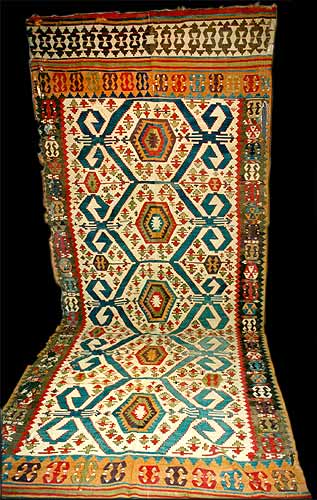
Dave
Re: Complimentary?
quote:
Originally posted by David R.E. Hunt
Find below an image of a Hotamis kelim I Googled.
Hi Steve -
As I'm sure you know, the use of nouns as verb forms isn't
a particularly recent development. It used to, and may still, drive English
composition teachers mad.
What may be more distinctive about recent
instances is that they seem often to occur now as the result of the dominance of
some brand or brand name.
When I was young, "Frigidaire" (although still
a noun usage) was often used to refer to any "refrigerator" regardless of brand.
I don't know if anything was ever "Frigidaired" (for "freezing" or "keeping
cool")
More recently, folks often talked about "a Xerox" or about
"Xeroxing" something instead of "photocopying" it.
I don't know video
games, but I'd be surprised if there hasn't been at some point a particular
video game or producer that became a generic term of this sort.
The Xerox
exmple also shows how quickly particular usages of this sort can become
obsolete. Xerox is no longer as dominant as it was in the photocopying field and
its use as a generic verb has, I think, declined.
I just looked around
for some possible similar usages in the rug world. One thing I see quickly that
may be a candidate is the term "kashmiring," which most will know refers both to
a kind of embroidery stitch used to make inexpensive repairs and to the process
of repairing using such a stitch. I'm not sure of its origin but it sounds
geographic.
I think we sometimes see "selvege" used as a verb form, as in
"the rug was selveged with dark goathair." And "warped" and "single-wefted" are
also possibilities.
So the basic move has gone on for some
time.
Regards,
R. John Howe
Hi,
I turkotek,
You turkotek,
He turkoteks,
She
turkoteks
We turkotek
They turkotek
I turkotekked
I'm
turkotekking
Aren't we all turkotekked?
Best
turkotekkings,
Vincent
Below, the motif from Rich Paine's piece followed by motifs from Louis
Dubreuil's Hotamish kilim, his 15th century Crevilli rug, and the center motif
from three c. 1900 Baluch chantehs (small bags). (For published examples of
Baluch chantehs with this motif see Black & Loveless, Rugs of the Wandering
Baluch and Boucher, Baluchi Woven Treasures.) This distinctive octagonal motif
has two squares joined to make rectangles that lie against four of the eight
sides of the octagon. Whether this motif should be termed 'hash gul' is unclear
to me, but in any event the continuity from 15th to 20th centuries seems
striking. Best regards, Frances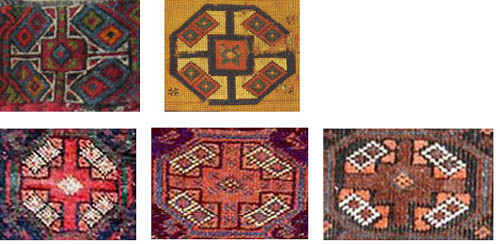
hash gul
Bonjour Frances
Thank you for your picture synthesis. Indeed this is
why this motif is interesting : a great continuity and stability from centuries
and also the fact that this motif is found on "sophisticated" rug as the
Crivelli star and on utilitary yomut or balutch bags.
For the name this
remain a mystery. The only author who spokes of this motif is Jourdan. In the
english issue of his book it is named "hash gul". I don't know if this is a
phonetic transposition of the yomut name or a translation. It would be
interesting to look at the german issue of the book to see how this motif is
named. I have asked Mr Jourdan about that but he was unable to find his notes
about this motif to give me an acurate answer.
We can see that,
unfortunatly, in a "well named" recent "definitive" guide of rug design there is
nothing about this motif.
Meilleures salutations
louis
Dubreuil
Constraints of Symmetry?
Louis and all
Just a couple of further variations of this
design.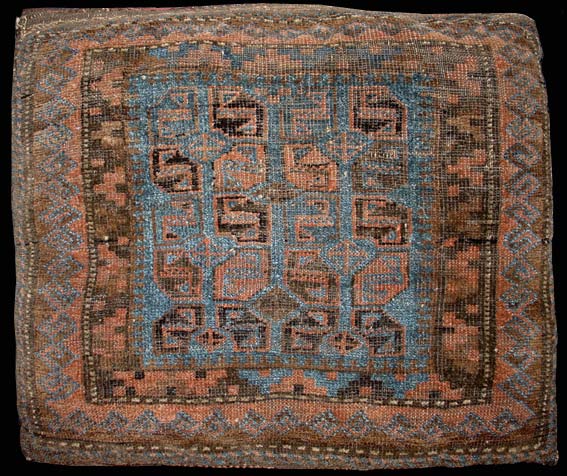
And again, this time in a late 19th century Bkharan coat of
Russian gold brocade
And a detail of
a persian minature, crca 1420 from "Antique carpets from the Near East" by W.
von Bode.
I still say the most common and central relationship of this
design lies more at the limitations imposed by geometry of design upon a two
dimensional surface than common ancestry or history of use other than perhaps a
regional characteristic. Follow this link to a discussion of symmetry and design
at the Textile Museum
Dave
Bonsoir Dave
The two figures don't follow the same rules. In the case
of the motifs you show this is the well known "intricated octagon pavement".
Each octagon shares a quarter with the diagonally placed others. In the case of
the hash gul the octagons are not intricated as the figure we can obtain by
recombining shared quarters doesn't give a similar motif. Hash gul octagons work
always as individual shapes. In the Crivelli example the hash gul is well a
singular motif working like a gul.
I have difficulties to follow the pure
"geometrical way" (the symetry and its rules) of considering rug design, or the
other theory of the "matter way" in which design is the slave of the weaving
technic. We can find the hash gul either in piled rugs and in flat weavings of
different technics and the motif remains the same. I have a personnal tendancy
to believe that it is rather the weaving technic that is the slave of the
design. The aim of the weaver is to reproduce the more faithfully motifs that
she have inherited. In this transmission there is often a derivation from the
original shape. In some cases, as for the hash gul, we can see however that the
shape remains strongly stable during a long time.
Meilleures salutations
à tous.
Louis Dubreuil
Close enough for me...
Dear Louis and All-
While ther are differences, some seeming more
sophisticated than others, they all still look close enough to be related by
symmetry. While there could of course be more to this relationship, I for one
require further evidence. I state again,
"the most common and central
relationship of this design lies more at the limitations imposed by geometry of
design upon a two dimensional surface than common ancestry or history of use
other than perhaps a regional characteristic."
I am not so much
saying you are wrong, as there could be some form of familial relationship, just
stating that I need a little more evidence .
Dave

There hangs a kilim, or what's left of it.
At the top
you can see something like a Hash Gul. A diamond and 4 S shapes.
Hotamis? I
donotno.
Best regards,
Vincent
Bonjour Vincent
I think the device you pointed at is nearer of the
design of the dave's Balutch bag face than of the original hash gul.
Your
kilim is nevertheless quite interesting. There is in it a particuliar device
situated in the third and fourth bands that makes me to think to the kurdish
Malatya/Sinan kilim bagface I have posted some weeks ago.
Amicales
salutations à tous
louis Dubreuil
PS I have found two other
examples of "Hash-guloid" devices in a piled Qashgai bagface in "Yoruk the
nomadic weaving tradition of the middle east" (plate 74) used as a scatered
field motif, and in a bakhtiari tacheh (from a french exhibition catalog of the
Galerie Sofreh). In this case it was used as individual motif, in the
bottleshape piled part and as an lonely little piled motif in the non piled
part. I'll soon send pictures to Steve.
Bonsoir à tous le amateurs de hash gul, here is the following story: three
new discoveries in the rug documentation
First: two little simplified
hash gul on a Chahar Mahal tacheh, found in the French exhibition catalog
"tacheh" made in July 2001 by the "Galerie Sofreh". I think there is always a
link with this gallery on Cloudband. The center of the hash gul is square on the
diagonal, not square on the horizontal line.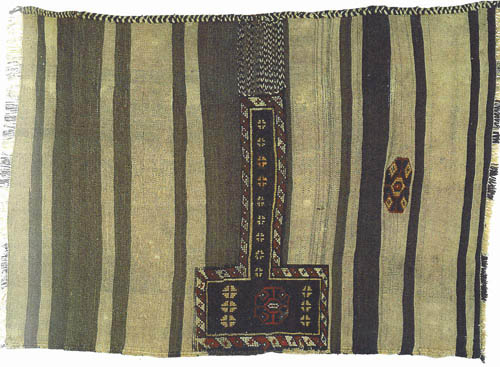


Second: three
kinds of hash gul devices on a Qasqai bag found in "YORUK" by Antony Landreau
(1978), page 106, plate 74. We can see in this bag face three kinds of hash gul
forms. The picture is dark, so I have put it in negative. We can see the hash
gul in A, B and C variants. A are little devices free and scattered in the
field, B is in the center of a Memling cross or free in the field, C is in the
center of a cross we can find four times in the central medallion. Here also the
center of the hash gul is a square on the diagonal line.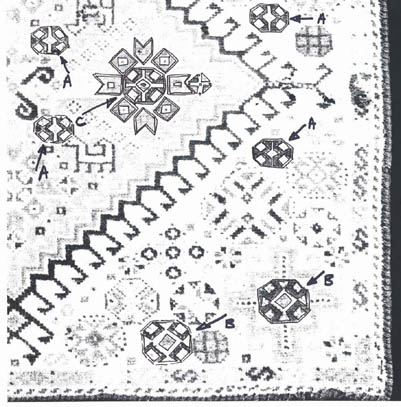

Third: central
motif on a Hazara (Mushwani) bag, found on Hali 53 (page 192). In this case the
hash gul is well centered and is the main design of the bag. This form is very
near of the Crivelli rug. The center motif is a little diagonal square in the
middle of an horizontal rectangular shape making the center of a
cross.
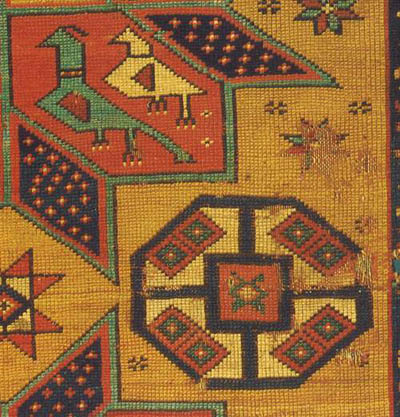
These three new examples show that, contrary of the Yomut use
of the motif (employed as a "pavement pattern" and with "S" in the cartouches),
we can find in late XIX or XX pieces the hash gul as a scattered or single field
motifs or as a center motif of crosses. In these examples the cartouches are not
filled with "S" and we find forms that are very near of ancient forms like the
Crivelli one.
Meilleures salutations à tous
Louis Dubreuil
It's everywhere....
Bonjour Louis and all
Another still, from a balouch prayer
rug.
So we Hotamis, Balouch,Quashgai, Chahar Mahal, Hazara, and
of course the suspect of origin, Turkish. But how are they related, other than
by geometry. Better yet, can we demonstrate a relationship which cannot be
explained by geometric association?
Need to define some group or groups
of weavers, all somehow related and sharing a core or cluster of
characteristics, such as geographic proximity in conjunction with the use of
this gul, over an established time frame. Pervasive use would also be a prime
indicator, but I'm not sure use as a filler device would
qualify.
Dave
Method
Hello David
I am thinking to a method of "tracking" HG and of
comparison of the motif and its uses in different weaving cultures. I have the
project of building some comparative tables, as we can find in the "definive
Stone" book, but more complete, including datas like spoken languages and
relations shared or not by the tribes who use HG. I think it could be usefull to
do the same thing with other shared motifs or design as "memling gul", "endless
knot" or others, in order to compare their repartition with the repartition of
HG. Maybe a comparative repartition map could be interesting.
It's my
objective for next weeks.
Amicales salutations
Louis
German Hash gul
Message for German speaking turkotekers
I would like to know how Uwe
Jourdan wrote "hash gul" in the german edition of his book about turkmen rugs.
In the english edition he spoke of this motif about a Yomut kordjin. I suppose
there are the same items in the german issue. It is just to know if "hash" is an
european phonetic transcription of a turkmen word or a translation in english of
a turkmen word meaning "hash".
Thanks for advance.
Louis